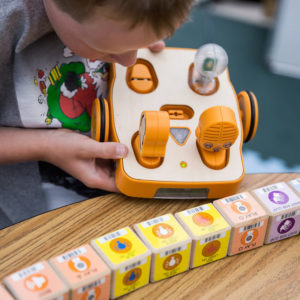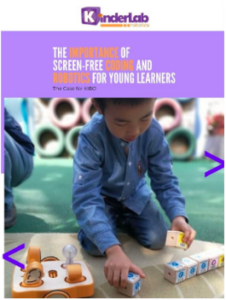Robotics in Early Childhood Education – Coding Develops Computational Thinking Skills
In this second blog of the new blog series, we share key reasons why early childhood educators should be incorporating robotics in their classrooms. In this blog, we are focusing on Key #2 – Coding Develops Computational Thinking Skills. See the other blogs in this series about the importance of robots in early learning with STEAM learning tools!
- Key 1 – Robotics in Early Childhood Education – Coding Teaches STEAM, the Literacy of the 21st Century
- Key 3 – Robotics in Early Childhood Education – Technology Becomes the Playground
- Key 4 – Robotics in Early Childhood Education – Robotics Makes Coding Tangible, Concrete…and Screen-Free!
- Key 5 – Robotics in Early Childhood Education – Using Technology Breaks Down Engineering Stereotypes
- Key 6 – Robotics in Early Childhood Education – The Engineering Design Process Develops Grit and Perseverance
Early childhood is a wonderful time to sparks kids’ interest in coding, robotics, and engineering. Young children are curious about the world around them, and today that world includes technology. But how can educators promote positive, creative, and educational engagement with technology with our youngest learners? Integrating robotics and coding for early learners is easier than you may think, with hands-on, screen-free tools like KIBO.
Robots in Early Childhood Education – Coding Develops Computational Thinking Skills
How do you solve a problem in a structured way? With computational thinking, you model the problem, break it down into smaller sequential steps, invent solutions, and test them out. The term “computational thinking” grew out of work in the 1980s by Seymour Papert, a pioneer in teaching children to create with code.
More recently, theorists and educators have begun to explore the connections between computational thinking and the cognitive skills developed in early childhood. For example, when children use code to create algorithms (a series of ordered steps to solve a problem) they develop their sequencing ability: a foundational skill for reading and mathematics.
Learn the 6 Key Benefits of Using Robotics with Your Youngest Students!
![]() Introduce coding and robotics into your early childhood classrooms – in a fun and playful way!
Introduce coding and robotics into your early childhood classrooms – in a fun and playful way!
Research States, “As early as pre-kindergarten, children are able to master foundational concepts regarding programming a robot and that children as young as 7 years old are able to master concepts as complex as programming a robot using conditional statements.” (Sullivan & Bers, 2015)
 When young children plan a sequence of actions for KIBO to perform, they assemble their program as a line of wooden command blocks. They scan the blocks with KIBO’s barcode scanner, one by one in sequence. When the robot acts out the sequence, children can follow along by referring to the blocks they’ve scanned. Using KIBO, educators can integrate coding into all curricular areas to promote literacy, math, science, engineering, and the arts through a project-based approach.
When young children plan a sequence of actions for KIBO to perform, they assemble their program as a line of wooden command blocks. They scan the blocks with KIBO’s barcode scanner, one by one in sequence. When the robot acts out the sequence, children can follow along by referring to the blocks they’ve scanned. Using KIBO, educators can integrate coding into all curricular areas to promote literacy, math, science, engineering, and the arts through a project-based approach.
Computational Thinking Research Behind the Scenes
KIBO’s programming method is rooted in years of research identifying the most effective ways to introduce coding in early childhood education. Research shows that young children can learn programming and engineering at a very early age. This is possible when children are given tools that are developmentally appropriate, that encourage open-ended play and that allow the integration of technical skills with expressive arts, math, literacy and cultural explorations.
Young kids learn by doing. They learn best by playing with physical objects: by making things, testing things. To learn programming and engineering, they need materials designed in the spirit of traditional learning manipulatives in early childhood (physical, as opposed to on-screen). Young children engage in playful learning, cultivate their curiosity for the technological world, explore problem solving, and understand concepts such as sequencing, cause-and-effect, programming, sensors and motors.
In the book Coding as a Playground: Programming and Computational Thinking in the Early Childhood Classroom, KinderLab Robotics’ co-founder and Chief Scientist, Dr. Marina Bers, focuses on how young children (ages 7 and under) can engage in computational thinking and be taught to become computer programmers, a process that can increase both their cognitive and social-emotional skills. She delves into how coding can engage young children as producers—and not merely consumers—of technology in a playful way.
Dr. Bers believes that coding promotes developmentally appropriate experiences such as problem solving, imagination, cognitive challenges, social interactions, motor skills development, emotional exploration, and making different choices.
What KIBO Robotics Offer Young Learners
KIBO, the coding robot, offers an inviting, engaging platform for children to start their journey into creating with code. KIBO’s block-based coding language gives children control over the robot’s movements, sounds, and sensors, allowing them to express their imaginations with code. And, when accompanied by our STEAM curriculum, young children are able to tell stories, create characters, and explore their world with KIBO.
Learn more about how the KIBO Robot can teach the fundamentals of programming in a fun and engaging way and our mission to introduce coding to children by watching Dr. Marina Bers’ Tedx Talk – Young programmers — think playgrounds, not playpens.
Stay turned for the next blog on additional key reasons why robotics is important for young learners.
Supporting research:
- Sullivan, A., & Bers, M.U. (2015). Robotics in the early childhood classroom: Learning outcomes from an 8-week robotics curriculum in pre-kindergarten through second grade. International Journal of Technology and Design Education.
- Kazakoff, E., Sullivan, A., & Bers, M.U. (2013). The effect of a classroom-based intensive robotics and programming workshop on sequencing ability in early childhood. Early Childhood Education Journal, 41(4), 245-255. doi:10.1007/ s10643-012-0554-5.
- Papert, S. (1980). Mindstorms: Children, computers and powerful ideas. New York: Basic books.



















